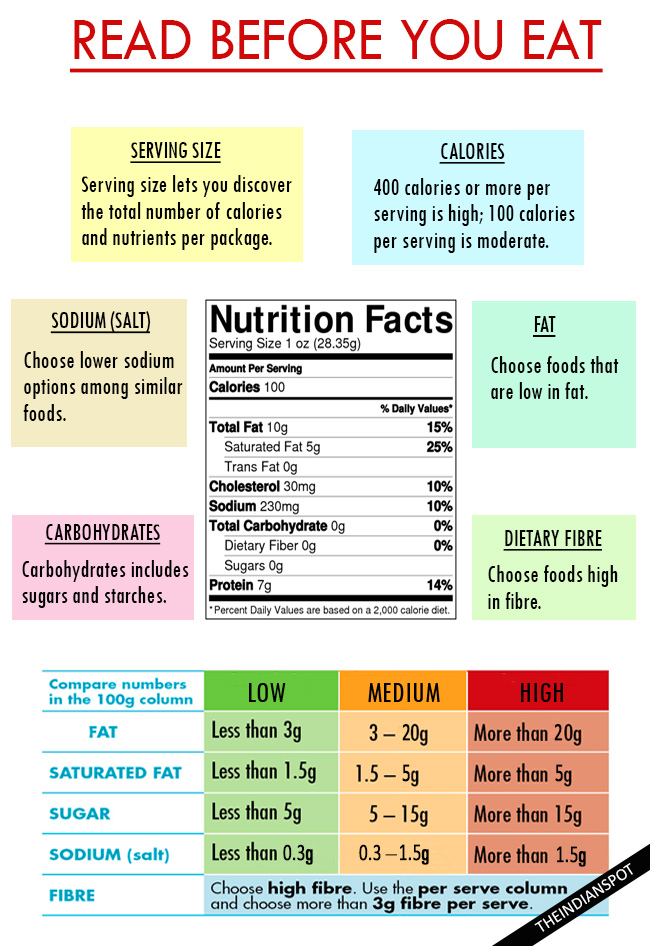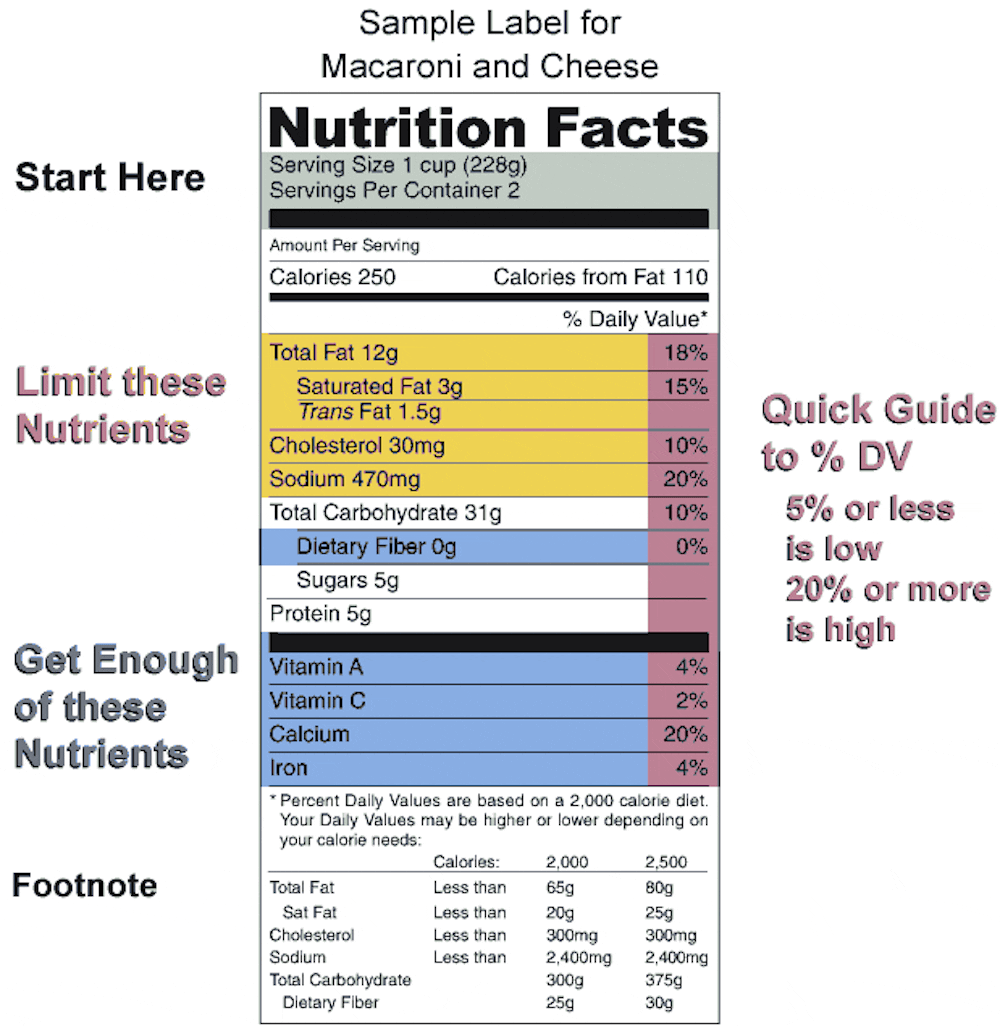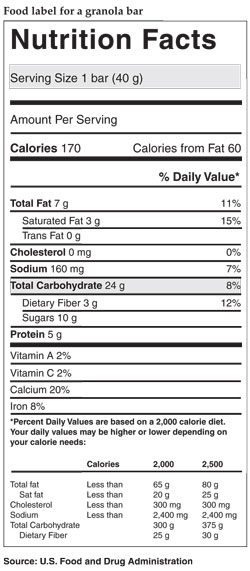45 how to understand calories on food labels
Understanding food labels - Canada.ca Find information on food labels and how to understand them. Learn about nutrition facts tables, serving size, list of ingredients, % daily value and nutrition claims. How to Read Everything on the Nutrition Facts Label - Food Network Let's say that number is 1600 calories. Take that 1600 and multiply it by 0.30 (based on our goal of getting 30% of our calories from fat). You'll get 480 calories. Then, to figure out the grams of...
How to understand food nutrition labels | by Alpha Medical Team | Alpha ... How to understand food nutrition labels Serving Size. At the top of the nutrition label is the serving size, which tells you how much of that food people... Calories per serving. This number tells you how much energy is contained in one serving of this food. Calories are units... Nutrient tables. ...
How to understand calories on food labels
Reading food labels shouldn't be complicated. Here's how to ... Jul 11, 2022 · Research from other countries has found that such easy-to-understand front-of-package labels can guide consumers to make healthier food choices. ... Food manufacturers have until January 1, 2026 ... 3 Ways to Calculate Food Calories - wikiHow Aug 09, 2022 · To calculate food calories, start by looking at how much protein, carbohydrates, and fat the food has. Then, multiply the total number of grams of protein by 4, since 1 gram of protein is equal to 4 calories. How to read nutrition facts on food labels? Food Labels to Read. Step 1: Determine the number of servings and the number of calories per serving. The serving size determines all of the information on a food label. Step 2: Determine the amount of fat in the dish. Step 3: Determine the amount of cholesterol in your system. Step 4: Make sure the sodium level is correct (salt).
How to understand calories on food labels. What are the 4 steps to reading food labels? - clambaronline.com What are the 4 steps to reading food labels? Step 1: Start with the Serving Size. Step 2: Compare the Total Calories to Your Individual Needs. Step 3: Let the Percent Daily Values Be a Guide. Step 4: Check Out the Nutrition Terms. Step 5: Choose Low in Saturated Fat, Added Sugars and Sodium. Calories for Hundreds of Foods: Your Calorie Chart Database Welcome to Calories.info, a food database that will help you discover the caloric content and other facts about common foods. When you use the calorie database to understand how your body gets energy out of your favorite meals and snacks, paying particular attention to the number of calories in food you’ve eaten, you’ll be empowered to make dietary choices that never leave you with guilt ... Understanding Food Nutrition Labels | American Heart Association Learn what to look for on the label. 1 - Start with the serving information at the top.. This will tell you the size of a single serving and the total number... 2 - Next, check total calories per serving and container.. Pay attention to the calories per serving and how many... 3 - Limit certain ... How to Understand and Use the Nutrition Facts Label | FDA How to Understand and Use the Nutrition Facts Label 1. Serving Information. When looking at the Nutrition Facts label, first take a look at the number of servings in the... 2. Calories. Calories provide a measure of how much energy you get from a serving of this food. In the example, there... 3. ...
How To Read Food Labels: Understanding the Basics - Instacart Using 2,000 calories as a baseline, you might use the calorie count on food labels to identify products that are high in calories or to determine how many pieces of something you can consume without risking over-indulging. Know your baselines: Percent daily values (%DV) How to Read Nutrition Labels Like a Dietitian - Consumer's Health Report At first glance, it may appear that the food is low in calories, carbohydrates, fat, sodium, etc. Then, when as a normal human being, you eat a much larger serving size than what is on the label, you actually consume many more calories, carbohydrates, fat, sodium, etc. than you realize, unless you remembered to do the math when you read the label. How To Read A Nutrition Label - Good Food Made Simple Check out % Daily Value. The % Daily Value puts nutrients on a scale from 0 to 100% and can be found on the right side of the label. This value essentially explains how much of a particular nutrient is in a serving of food. If something contains 5% Daily Value or less, it's considered a small amount, whereas 15% Daily Value is a lot. How to read nutrition labels - calories in foods How to read a nutrition label. Every packaged food that you pick up has to provide you with certain information by law. This information relates to the ingredients and nutritional value of the food, and can be found by reading the nutrition facts label, which is always clearly highlighted on the exterior of the packaging.
How to read food labels: MedlinePlus Medical Encyclopedia If you eat 2 cups (0.48 liters) at a meal, you are eating 2 servings. That is 2 times the amount of the calories, fats, and other nutrients listed on the label. Calorie information tells you the number of calories in 1 serving. Adjust the number of calories if you eat smaller or larger portions. Food Labels Explained: Nutrition Information Labels One of the first things that we look for on a food label is calories, which can be found under the name of kilojoules (kj) or kilocalories (kcal). The energy value is very important for our health, but it should mainly come from nutrient-dense foods. How to understand food labels | Eat For Health Sometimes labels will include nutrition content claims like 'low fat', 'reduced salt' or 'high fibre'. These claims can only be used if the food meets certain criteria. For example, with a 'good source of calcium' claim, the food must contain more than a set amount of calcium. While nutrition content claims can generally guide ... How To Read Nutrition Labels - Mayo Clinic Diet All the nutrition info — including calories — refer to the amount in one serving. 2. Check the calories in one serving 40 calories is low, 100 calories is moderate, 400 calories or more is high. Remember: If you eat multiple servings, you'll need to multiply the calories by the number of serving that you eat. 3. Check the % Daily Value
PDF How to Read the Food Label - University of California, Santa Cruz Always check the serving size (see sample label on page 2). Calories. This is the number of calories you'll eat in . one serving of a food. Calories needed each day depends on your age, sex, height, weight, and amount of physical activity. Estimates range from 1,600 to 2,400 calories for women and 2,000 to 3,000 calories for men.
Food labels - NHS These labels include information on energy in kilojoules (kJ) and kilocalories (kcal), usually referred to as calories. They also include information on fat, saturates (saturated fat), carbohydrate, sugars, protein and salt. All nutrition information is provided per 100 grams and sometimes per portion of the food.

UNDERSTANDING FOOD LABELS - MAKE THE BEST FOOD DECISIONS (With images) | Reading food labels ...
6 Free Printable Food Labels Worksheet & Different Types Some specific rules and laws need to be followed on a food labels worksheet. A food labels worksheet can be used to ensure that the labels on the product comply with federal standards. The following tips can help you create a food labels worksheet: Consider having a sheet for each of the major sections of a label
How-To Guide for Reading Food Labels - The Society for Cardiovascular ... The General Guide to Calories provides a general reference for calories when you look at a Nutrition Facts label. This guide is based on a 2,000 calorie diet. 3. Limit These Nutrients. When following heart-healthy guidelines, it is helpful to use the Nutrition Facts Panel to find information about fat, cholesterol and sodium in foods. These are ...
How To Read A Food Nutrition Label | Gobble Eating fewer calories per day than you burn is a reliable way to lose weight. Calories are listed on Nutrition Labels in bold letters right beneath the serving size at the top of the table. Remember that if you eat a larger portion than the recommended serving size, this number may only reflect a percent of the total calories you consume. Nutrients
PDF How Do I Understand the "Nutrition Facts" Label? number of calories you've eaten. • Calories — tell you how much energy is in the food. It's important to pay attention to calories if you're trying to lose weight or manage your weight. • Total Fat — is the amount of fat found in one serving of the food. Total fat includes the amount of "bad fats"
Understanding Food Nutrition Labels - Calorie Control Council Always looking at the Nutrition Facts label helps cut through the buzzword jargon. First, it's important to understand that sugar is not fat. Sugar is listed under the carbohydrates, which is also where you find fiber. When looking to reduce your calorie intake, choosing items using low calorie sweeteners like allulose really come in handy.
How to read a food nutrition label (correctly) | GQ India Calories This value refers to the amount of energy one serving of this food is giving you. A food can be classified as low-cal if it's less than 40 calories/serving, and calorie-free if it contains...
Understanding Nutrition Labels - Facty Health Understanding Nutrition Labels. Food manufacturing companies in the U.S. are required by law to label all food products. They are legally required to provide information about calories, fat, sugar, salt, and nutritional values so that consumers can make informed decisions about their purchases. A lot of this information can feel alien, though ...
How to Read a Nutrition Label | Blue365 Deals Use this guide from the experts at Blue Apron to help interpret labels and make the healthiest choices for your diet. Start with the list of ingredients. Look for fewer processed foods and more fresh vegetables, fruits, proteins and whole grains. Check out the nutrition label. It lays out the quantities of carbohydrates, protein, fat, and other ...
Understanding Food Labels | The Nutrition Source | Harvard T ... Chile implemented the Law of Food Labeling and Advertising in 2016, comprised of mandatory front-of-package (FOP) warning labels, restrictions on child-directed marketing, and the banning of sales in schools of all foods and beverages containing added sugars, sodium, or saturated fats that exceeded set nutrient or calorie thresholds. [1]
How Do They Calculate Calories on Food Labels? Finally, the calories are determined by calculating the change in water temperature multiplied by the volume of water. Calories on food labels. The 1990 Nutrition Labeling and Education Act (NLEA) for the first time required that food manufacturers put the amounts of nutrients and calories on the package label.

How To Read Food Nutrition Labels: Learn The Nutritional Content And Calories Of What You're ...
Parents' Guide To Reading & Understanding Food Labels The servings portion of the label should have a total number of servings per package and a recommended serving size. The calories section of the label refers to the number of calories or amount of energy in each serving, not the entire package. L closely, you can often see the phrase "amount per serving" above the larger print of "calories."
How To Read Food and Beverage Labels - National Institute on Aging At the top of the Nutrition Facts label, you will find the total number of servings in the container and the food or beverage's serving size. The serving size on the label is based on the amount of food that people may typically eat at one time and is not a recommendation of how much to eat. Read more about serving and portion sizes.
Calories on the New Nutrition Facts Label | FDA 2,000 calories a day is used as a general guide for nutrition advice, but your calorie needs may be higher or lower depending on your age, sex, height, weight, and physical activity level. Eating ...
How to read nutrition facts on food labels? Food Labels to Read. Step 1: Determine the number of servings and the number of calories per serving. The serving size determines all of the information on a food label. Step 2: Determine the amount of fat in the dish. Step 3: Determine the amount of cholesterol in your system. Step 4: Make sure the sodium level is correct (salt).












Post a Comment for "45 how to understand calories on food labels"